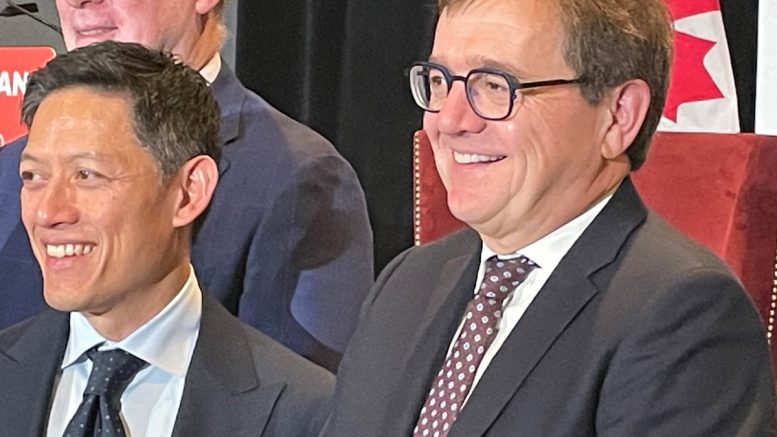Less than a year after the federal government approved the takeover of Neo Lithium by China’s Zijin Mining without a full national security review under the Canada Investment Act, it has signalled an entirely new approach to Chinese investment in Canada’s critical minerals sector. The Minister of Innovation, Science and Industry, François-Philippe Champagne and Natural Resources Minister Jonathan Wilkinson issued new guidelines on Oct. 28 regarding foreign investment in the sector, which is key to Canada’s competitiveness in a future low-carbon global economy. Had they been in place at the time of the Neo Lithium takeover, which closed in January this year, it’s probable — if not 100% certain — that the deal would have been rejected.
The policy includes guidance on transactions that involve critical minerals assets when the proposed buyer is either a foreign state-owned enterprise (SOE), or assessed as being subject to influence by foreign governments — particularly “non-likeminded governments.”
It shuts the door on foreign SOEs acquiring controlling stakes in critical mineral assets, and makes clear that deals above a certain threshold, already subject to a net benefit review by the ministry of industry, would now only be approved “on an exceptional basis.”
Investments by SOEs in critical minerals projects at any stage, including greenfield projects, are also subject to a national security review — whether or not they involve a controlling stake. (The review considers factors including the size, scope and location of the Canadian entity; the strategic value of the asset or supply chains involved; and the degree of influence the investment would allow an SOE over the company and supply chain.)
Just a few days after this newly assertive policy was released, Minister Champagne ordered three Chinese firms to sell their stakes in three Canadian juniors, Power Metals, Lithium Chile and Ultra Lithium.
All three juniors have much earlier stage projects than Neo Lithium’s 3Q lithium brine project in Argentina, and it’s not clear why they were flagged on national security grounds over companies with more advanced projects.

Inside the processing plant at Neo Lithium’s Tres Quebradas (3Q) lithium brine project in Argentina. Credit: Neo Lithium.
Zirjan Derwa, a partner at Bennett Jones with a focus on Canadian competition law and foreign investment matters, who sees the new approach as a “significant” policy shift, said there was no precedent for the divestment order.
“Prior to these ordered divestments there hadn’t been a case where a critical mineral asset was ordered to be divested in Canada,” he said in an interview, noting that Shandong Gold Mining’s proposed takeover of TMAC Resources in 2020 was rejected because of the strategic Arctic location of TMAC’s Hope Bay project.
The order caught the affected juniors, which have Chinese ownership ranging from around 5.7% to just under 20%, by surprise.
Lithium Chile, for example, has only counted Chengze Lithium International, which held 19.4% of the company, a shareholder for less than a year. The junior with assets in Argentina and Chile welcomed two new members to its board from Chengxin Lithium Group (Chengze’s parent company) just one day before the divestment order.
While the scope and implementation of the policy is still unclear, Lithium Chile’s inclusion on the divestment list demonstrates that assets outside of Canada are considered fair game for national security reviews.
The more aggressive stance on who is allowed to invest in the sector is not likely to end with these three companies and could intensify in the future, analysts say.
“While presently limited in scope, we see this announcement as a signal of the future landscape for foreign direct investment in Canadian critical minerals,” Katie Lachapelle, a mining analyst with Canaccord Genuity, wrote in a Nov. 3 note to clients. “Today’s announcement solidifies Canada as a jurisdiction where the involvement of the Chinese (and potentially other foreign SOEs) will likely not be permitted to invest whether it be a direct equity investment, minority stake/takeout, etc.”
Sander Grieve, head of the mining team and a partner at Bennett Jones, notes that Canada is a net recipient of foreign direct investment, and as a relatively small economy among the G7, has historically relied on foreign capital to build major projects.
“There appear to be a class of investors that are being cautioned that their investment may not be welcome in Canada at this point,” Grieve said in an interview. “I think the question that industry’s got to have top of mind is if that decision is made by the government that there are certain investors we don’t want, what will be done to encourage the investors we do want, as we clearly are creating a hole in the Canadian economy for the development of projects?”
On that point, friendly nations could see the red carpet rolled out for them — unlike the cold rejection experienced by China. (A spokesperson for China’s foreign ministry protested that Canada has “overstretched the concept of national security and placed arbitrary curbs on normal trade and investment cooperation between China and Canadian companies,” as reported by the Financial Post.)
However, there is still a question about investment from states other than China, Grieve says.
“There’s been a lot of focus on China in particular in this policy, but it is an SOE policy and there are a lot of SOEs in the broader global economy from various states, so this should be expected to have wider implications for foreign direct investment into Canada and into Canadian companies.”
Lachapelle notes that the new direction could serve to bolster investment from countries with similar values and interests.
“We also believe that the Canadian government could play a notable role in investment/financing,” she wrote.
Further announcements related to Canada’s nearly $4-billion Critical Minerals Strategy, unveiled earlier this year, are expected this fall.







Be the first to comment on "Canada draws a line on critical minerals, but leaves unanswered questions"